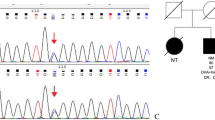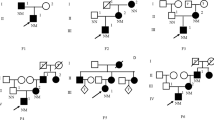Abstract
Objectives
During examining the prevalence of mutations in NeuroD1/BETA2 gene in Chinese early-onset type 2 diabetic probands, a novel missense mutation, Ser159Pro in a potential MODY family was identified. To investigate the role of the mutation in early-onset diabetes, we studied its transcriptional activity on human insulin gene and clinical characteristics of the family with the mutation.
Methods
Bi-directional sequencing of NeuroD1/BETA2 was performed in 85 early-onset type 2 diabetic probands without mutations in HNF4α, glucokinase, HNF1α, IPF-1 and HNF1β genes, 95 late-onset type 2 diabetics with strong diabetic history and 87 non-diabetic control subjects. The function of the Ser159Pro to the transcription of a human insulin promotor-linked luciferase reporter gene in rat INS-1 cells was tested using Dual-Luciferase® Reporter Assay System. Clinical phenotypes of the family with the Ser159Pro mutation were examined and analyzed.
Results
A novel mutation, Ser159Pro were found in a 27-years-old proband with both parents had diabetes. The mutation was transmitted in the heterozygous state and co-segregated with diabetes in four out of five carriers from the paternal side. Expect for the proband, all of other members with this mutation in the family, however, were diagnosed with diabetes after 50-years-old. The functional study showed that the mutant protein exhibited a 25% reduction in transcriptional activity of insulin gene when compared with the wild type.
Conclusions
These results suggest that the novel Ser159Pro mutation in the NeuroD1/BETA2 gene contributes to the development of diabetes in a Chinese potential MODY family.


Similar content being viewed by others
Abbreviations
- ND1:
-
Neuro D1
- T2DM:
-
Type 2 diabetes mellitus
- mND1-WT-Flag:
-
Flag tagged full-length mouse neuroD1-Wild type cDNA
- mND1-S159P-Flag:
-
Flag tagged full-length mouse NeuroD1 mutant-type (Ser159Pro) cDNA
References
Fajans SS, Bell GI, Polonskyn KS (2001) Molecular mechanisms and clinical pathophysiology of maturity-onset diabetes of the young. N Engl J Med 345:971–980
Ng MC, Lee SC, Ko GT et al (2001) Familial early-onset type 2 diabetes in Chinese patients: obesity and genetics have more significant roles than autoimmunity. Diabet Care 24:663–671
Ng MC, Cockburn BN, Lindner TH et al (1999) Molecular genetics of diabetes mellitus in Chinese subjects: identification of mutations in glucokinase and hepatocyte nuclear factor-1alpha genes in patients with early-onset type 2 diabetes mellitus/MODY. Diabet Med 16(11):956–963
Naya FJ, Stellrecht CM, Tsai MJ (1995) Tissue-specific regulation of the insulin gene by a novel basic helix-loop-helix transcription factor. Genes Dev 9:1009–1019
Tamimi R, Steingrimsson E, Copeland NG et al (1996) The NEUROD gene maps to human chromosome 2q32 and mouse chromosome 2. Genomics 34:418–421
Naya FJ, Huang HP, Qiu Y et al (1997) Diabetes, defective pancreatic morphogenesis, and abnormal enteroendocrine differentiation in BETA2/neuroD -deficient mice. Genes Dev 11(18):2323–2334
Huang HP, Chu K, Nemoz-Gaillard E et al (2002) Neogenesis of beta cells in adult BETA2/NeuroD-deficient mice. Mol Endocrinol 16(3):541–551
Fajans SS, Bell GI, Polonsky KS (2001) Molecular mechanisms and clinical pathophysiology of maturity-onset diabetes of the young. N Engl J Med 345:971–980
Malecki MT, Jhala US, Antonellis A et al (1999) Mutations in NEUROD1 are associated with the development of type 2 diabetes mellitus. Nat Genet 23:323–328
Kristinsson SY, Thorolfsdottir ET, Talseth B et al (2001) MODY in Iceland is associated with mutations in HNF-1alpha and a novel mutation in NeuroD1. Diabetologia 44(11):2098–2103
The Expert Committee on the Diagnosis, Classification of Diabetes Mellitus (2003) Report of the Expert Committee On The Diagnosis And Classification Of Diabetes Mellitus (position statement). Diabet Care 26(Suppl 1):S5–S24
Frayling TM, Evans JC, Bulman MP et al (2001) Beta-cell genes and diabetes: molecular and clinical characterization of mutations in transcription factors. Diabetes 50(Suppl 1):S94–S100
Fukui M, Nakano K, Obayashi H et al (1997) High prevalence of mitochondrial diabetes mellitus in Japanese patients with major risk factors. Metabolism 46(7):793–795
Sambrook J, Fritsch E, Maniatis T (1989) A laboratory manual. Molecular cloning, 2nd edn. Cold Spring Harbor, NY, Cold Spring Harbor Laboratory Press, P.E3–E4
Furuta H, Horikawa Y, Iwasaki N et al (1998) Beta-cell transcription factors and diabetes: mutations in the coding region of the BETA2/NeuroD1 (NEUROD1) and Nkx2.2 (NKX2B) genes are not associated with maturity-onset diabetes of the young in Japanese. Diabetes 47(8):1356–1358
Osawa H, Onuma H, Murakami A et al (2001) Systematic search for single nucleotide polymorphisms in the insulin gene: evidence for a high frequency of -23T→A in Japanese subjects. Biochem Biophys Res Commun 286(3):451–455
Yamagata K, Furuta H, Oda N et al (1996) Mutations in the hepatocyte nuclear factor-4alpha gene in maturity-onset diabetes of the young (MODY1). Nature 384:458–460
Froguel P, Zouali H, Vionnet N (1993) Familial hyperglycemia due to mutations in glucokinase. Definition of a subtype of diabetes mellitus. N Engl J Med 328(10):697–702
Yamagata K, Oda N, Kaisaki PJ et al (1996) Mutations in the hepatocyte nuclear factor-4alpha gene in maturity-onset diabetes of the young (MODY1). Nature 384:455–458
Chevre JC, Hani EH, Stoffers DA et al (1998) Insulin promoter factor 1 gene is not a major cause of maturity-onset diabetes of the young in French Caucasians. Diabetes 47(5):843–844
Beards F, Frayling T, Bulman M et al (1998) Mutations in hepatocyte nuclear factor 1beta are not a common cause of maturity-onset diabetes of the young in the U.K. Diabetes 47(7):1152–1154
Liu L, Jia W, Zheng T et al (2006) Ala45Thr variation in neuroD1 gene is associated with early-onset type2 diabeteswithor without diabetic pedigree in Chinese. Mol Cell Biochem 290(1–2):199–204
Sharma A, Moore M, Marcora E et al (1999) The NeuroD1/BETA2 sequence essential for insulin gene transcription colocalize with those necessary for neurogenesis and p300/CREB binding protein binding. Mol Cell Biol 19:704–713
Khoo S, Griffen SC, Xia Y et al (2003) Regulation of insulin gene transcription by ERK1 and ERK2 in pancreatic beta cells. J Biol Chem, 278(35):32969–32977
Acknowledgments
This research was supported by the Shanghai Scientific & Technical Committee Foundation (02DJ14052-I) and by Grant-in-Aid for Scientific Research on Priority Areas “Applied Genomics “ no. 17019047 from the Ministry of Education, Culture, Sports, Science and Technology of Japan.
We also thank Dr. Masahiro Nishi, Huijuan Lu, Jing Xu, Xiaojing Ma, Junxi Lu, and Xiaoping Pan for their technical support and cooperation.
Author information
Authors and Affiliations
Corresponding author
Rights and permissions
About this article
Cite this article
Liu, L., Furuta, H., Minami, A. et al. A novel mutation, Ser159Pro in the NeuroD1/BETA2 gene contributes to the development of diabetes in a Chinese potential MODY family. Mol Cell Biochem 303, 115–120 (2007). https://doi.org/10.1007/s11010-007-9463-0
Received:
Accepted:
Published:
Issue Date:
DOI: https://doi.org/10.1007/s11010-007-9463-0




